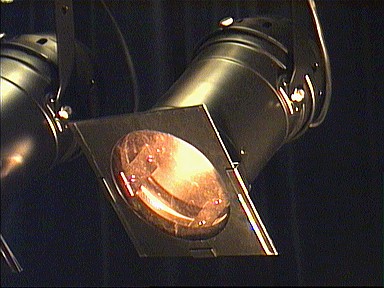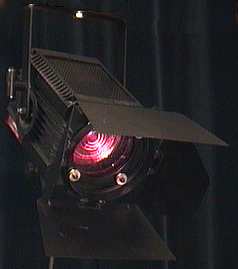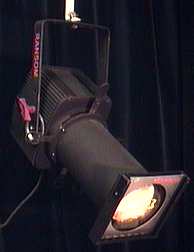 @Lighting Workshop.com
@Lighting Workshop.com @Lighting Workshop.com @Lighting Workshop.com |
| Lighting Workshop Home Types of Lantern Moving Lights Gobo Sizes |
Theatre LanternsThere are hundreds of different makes and models of lantern in use in theatres throughout the world but they all fit into one of the following categories: Profile, flood, fresnel, followspot, PC, moving yoke, moving mirror or PAR. We will now look at each type and see how they work and what they are used for. Flood A floodlight, in simple terms, is a lamp with a reflector behind it. The reflector is generally stippled to produce a soft "flood" of light. When we use the term "flood" with respect to light we mean a beam of light that illuminates a large area in a relatively uncontrolled manor. This type of lantern is available with two field distributions: Symmetric and asymmetric. Asymmetric floodlights have the lamp located off-centre with respect to the reflector which results in the field being brighter along one edge and decreasing as we approach the opposite edge. The purpose of this is to enable even illumination of a cyclorama from either the top or the bottom. On the other hand, symmetric floods have a fairly flat field that is intended for overhead lighting and other situations where an even flood of light is required. The latest technology in this area replaces the filament lamp with an array of light emitting diodes (LEDs). LEDs are of the order of 90% efficient which means that more light is produced for the energy put in, thus LEDs run almost cold. PAR (lanterns for reflector lamps) 
PAR lanterns (commonly called PAR cans) are the cheapest theatre lantern comprising of a reflector (PAR) lamp, colour filter holder and some chassis to enclose the lamp. PAR lamps come in a range of powers and beam sizes from about 30W to 1000W with beam sizes from a pin spot to wide flood. These lanterns are ideal for lighting live music such as concerts and any other application where a large number of lanterns are required or where weight is limited. PC There is some inconsistency between manufacturers with respect what PC stands for. Apart from meaning personal computer and politically correct, PC is also defined as prism-convex, pebble-convex and plano-convex. The latter meaning something with one flat surface and one convex surface (curved outward like a section of a sphere), in this case a convex lens with a flat back. A variation of this is the prism-convex lens, with one side convex and the other flat with hundreds of small prisms. Thus the abbreviation PC (with respect to lighting!) will mean prism-convex. Now I have defined what I mean by PC I can describe what a prism-convex (PC) lantern is. These lanterns have a semi-spherical reflector mounted closely behind the lamp such that the filament is located at the radius of curvature of the reflector. This results in light arriving at the reflector being reflected back along the axis of incidence. The light then passes forward to a lens that focuses the light into a controllable beam. By moving the lamp and reflector assembly back and forth the beam angle can be varied from a narrow spot (away from lens) to a wide beam (near lens). The lens has a stippled back that softens the beam edge and smoothes the field. Beam shape is controlled by "barn doors" attached to the front of the lantern and each leaf can be opened or closed to shape the beam. 
Fresnel A fresnel lantern is named after the fresnel lens that is used in these lanterns. The optics are identical to a PC lantern except that the PC lens is replaced with a fresnel lens. The best way to describe a fresnel lens is a prism-convex lens cut into concentric rings with each ring cut down to the same height. This results in a stepped lens with a flat profile. The steps or risers causes scattering of the beam resulting in a much softer beam edge than a PC lantern. Fresnels are generally used over the stage where absolute control of the beam is not critical and diffraction occurring at the edge of the lens and from the risers will not cause a problem. Profile There are two types of optical system used in profile lanterns. The cheapest, thus most popular use only a reflector but for improved optical performance profiles with condenser lenses can be obtained. Firstly I will describe the optics for a standard profile. The reflector/lamp assembly is designed such that the gate assembly, which in short, is a slot for beam shaping shutters and other accessories, is evenly illuminated. The light leaves the gate and arrives in the lens tube where one or two lenses set the angle and focus of the beam arriving at the stage. It is important that most of the light passing through the gate is collected by the lens system, otherwise the optics would prove to be extremely inefficient. The simplest lens system comprises a single plano-convex lens which can be moved back and fourth relative to the gate. This allows the projection of a hard or soft edge beam. The introduction of a second plano-convex lens (movable relative to the first lens) allows the lantern to produce a range of beam angles with a hard or soft edge. 
The second type of profile is the condenser profile. The only real difference with this type of lantern is that the reflector is replaced with a spherical one and a condenser lens is placed between the lamp and gate. The advantage of this system is that it produces a much "cleaner", sharper image of the gate. The light distribution across the field (beam) can be adjusted by moving the lamp back and fourth with respect to the reflector. This means it is possible to produce a beam that is brighter in the middle (peek) or totally flat distribution. Flat beam distribution is generally used when projecting images where as a beam distribution with a peek in the centre is handy when several beams overlap. The gate in profiles is circular, thus we get a circular beam out, but by inserting shutter blades it is possible to create a beam with straight edges. Shutter blades are the equivalent of barn doors on a fresnel but the difference is that shutter blades are not fixed perpendicularly to each other so a wide variety of shapes can be produced. If the beam angle is too wide for a particular application then an iris can be installed into the gate. An iris has a variable size hole in the centre that allows the beam diameter to be significantly reduced, however this is very inefficient and it is usually more desirable to use a narrower angle lantern. Another purpose of the gate is to allow the insertion of gobos. A gobo is a metal disk with an image cut out of it, such that light shines through the holes and is to the profile lantern what a slide is to a slide projector. In summary, the profile lantern is the most versatile of the ordinary theatre lanterns and, with a few modifications, can become a manually operated lantern for spotlighting actors i.e. the Followspot. Followspot A followspot is basically a modified profile. The optics are the same as a profile but a followspot has much smoother pan and tilt with several grab handles mounted on the back and sides. Followspots have a narrow beam angle, high power lamp and are designed to be used over a longer throw than profile lanterns are. |
  |
| © 2006 |